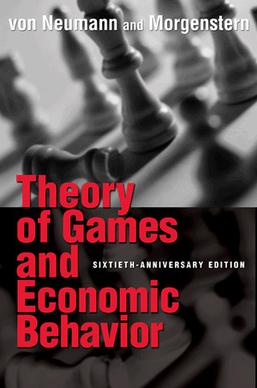Top Qs
Timeline
Chat
Perspective
Theory of Games and Economic Behavior
Book by John von Neumann From Wikipedia, the free encyclopedia
Remove ads
Theory of Games and Economic Behavior, published in 1944[1] by Princeton University Press, is a book by mathematician John von Neumann and economist Oskar Morgenstern which is considered the groundbreaking text that created the interdisciplinary research field of game theory.[2][3][4][5] In the introduction of its 60th anniversary commemorative edition from the Princeton University Press, the book is described as "the classic work upon which modern-day game theory is based."
Remove ads
Overview
Summarize
Perspective
The book is based partly on earlier research by von Neumann, published in 1928 under the German title "Zur Theorie der Gesellschaftsspiele" ("On the Theory of Board Games").[6]
The derivation of expected utility from its axioms appeared in an appendix to the Second Edition (1947). Von Neumann and Morgenstern used objective probabilities, supposing that all the agents had the same probability distribution, as a convenience. However, Neumann and Morgenstern mentioned that a theory of subjective probability could be provided, and this task was completed by Jimmie Savage in 1954 [7] and Johann Pfanzagl in 1967.[8] Savage extended von Neumann and Morgenstern's axioms of rational preferences to endogenize probability and make it subjective. He then used Bayes' theorem to update these subject probabilities in light of new information, thus linking rational choice and inference.
The book begins with a preface. This is then followed by a chapter on the Formulation of the Economic Problem and one on a General Formal Description of Games of Strategy. Zero sum games are then introduced. Firstly with a chapter on a Theory of Zero-Sum Two-Person Games, then one on Examples, and then one on Three-Person Games Zero Sum games. A General Theory: Zero-Sum N-Person Games is offered and then a chapter on Four-Person Zero-Sum games. After these is a chapter offering Some Remarks Concerning N ≧ 5 Participants Games. Then chapters on the Composition and Decomposition of Games, one on Simple Games and one on General Non-Zero-Sum Games are provided. The final chapter is on Extensions of the Concepts of Domination and Solution. After this at the end of the book there is an appendix offering an Axiomatic Treatment of Utility.[9]
Remove ads
Reception
Richard Stone (1948) Asserts that Unquestionably, for economists this book is the most important contribution that has appeared since J. M. Keynes's General Theory was published in 1936. It is concerned with the behaviour of individuals, and the coalitions which they may form in attempting to better themselves. It is directed therefore to the kinds of problem that are met with in the theory of value, and especially those that arise under conditions of duopoly, imperfect competition and the like. (p. 185)[10]
Herbert A. Simon praised the book.[11]
Remove ads
See also
- Pfanzagl, J (1967). "Subjective Probability Derived from the Morgenstern-von Neumann Utility Theory". In Martin Shubik (ed.). Essays in Mathematical Economics In Honor of Oskar Morgenstern. Princeton University Press. pp. 237–251.
- Pfanzagl, J. in cooperation with V. Baumann and H. Huber (1968). "Events, Utility and Subjective Probability". Theory of Measurement. Wiley. pp. 195–220.
- Morgenstern, Oskar (1976). "Some Reflections on Utility". In Andrew Schotter (ed.). Selected Economic Writings of Oskar Morgenstern. New York University Press. pp. 65–70.
- Morgenstern Oskar (1976). "The Collaboration Between Oskar Morgenstern and John von Neumann on the Theory of Games". Journal of Economic Literature. 14 (3): 805–816. JSTOR 2722628.
- Commemorative edition of the book Theory of Games and Economic Behavior
- Copeland A. H. (1945). "Review of 'The Theory of Games and Economic Behavior". Bulletin of the American Mathematical Society. 51: 498–504. doi:10.1090/s0002-9904-1945-08391-8.
- Hurwicz Leonid (1945). "The Theory of Economic Behavior". American Economic Review. 35 (5): 909–925. JSTOR 1812602.
- Kaysen Carl (1946). "A Revolution in Economic Theory?". Review of Economic Studies. 14 (1): 1–15. doi:10.2307/2295753. JSTOR 2295753.
- Marschak Jacob (1946). "Neumann's and Morgenstern's New Approach to Static Economics" (PDF). Journal of Political Economy. 54 (2): 97–115. doi:10.1086/256327. S2CID 154536775.
- Stone Richard (1948). "The Theory of Games". Economic Journal. 58 (230): 185–201. doi:10.2307/2225934. JSTOR 2225934.
References
External links
Wikiwand - on
Seamless Wikipedia browsing. On steroids.
Remove ads

